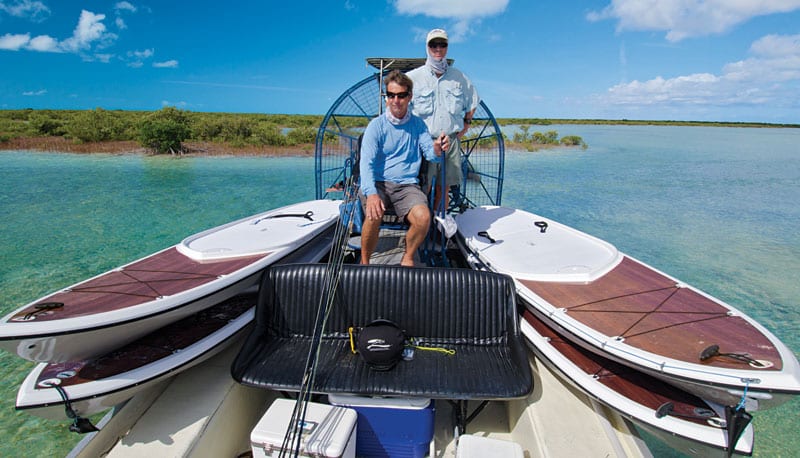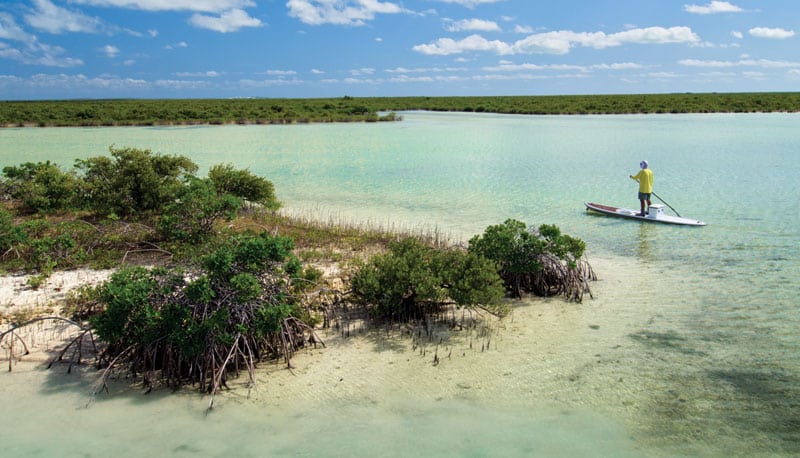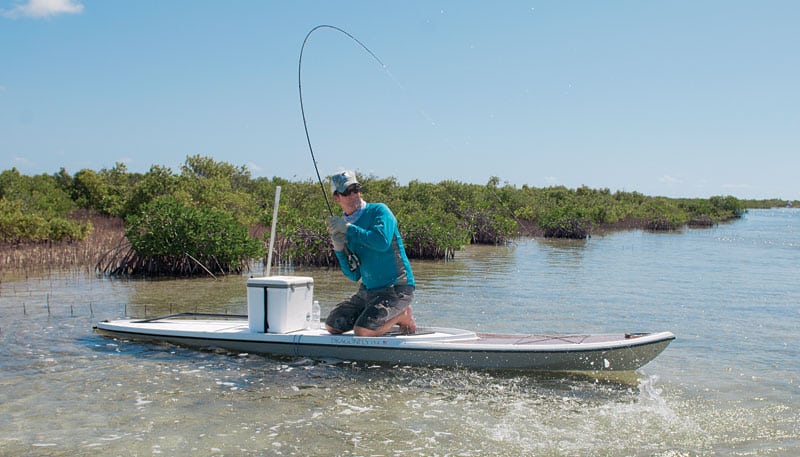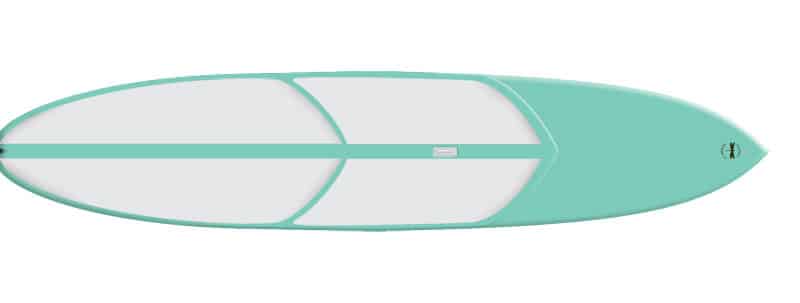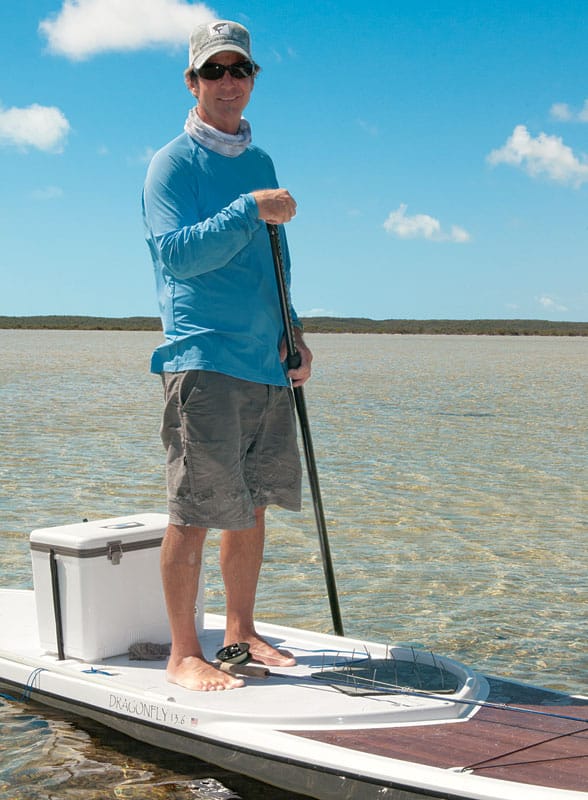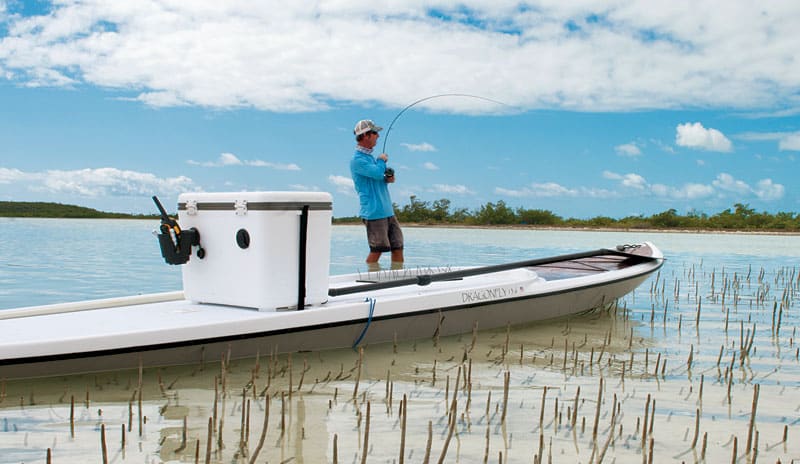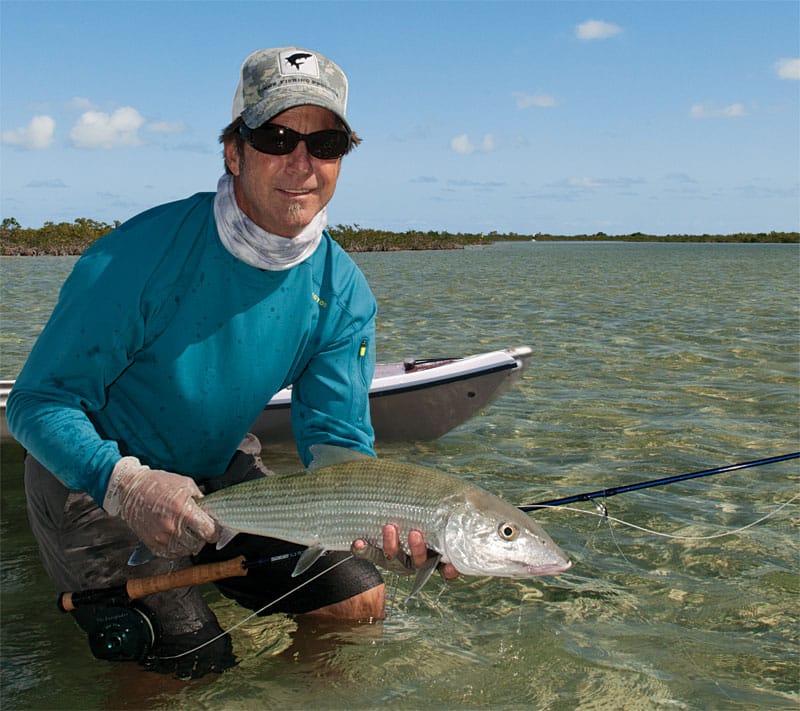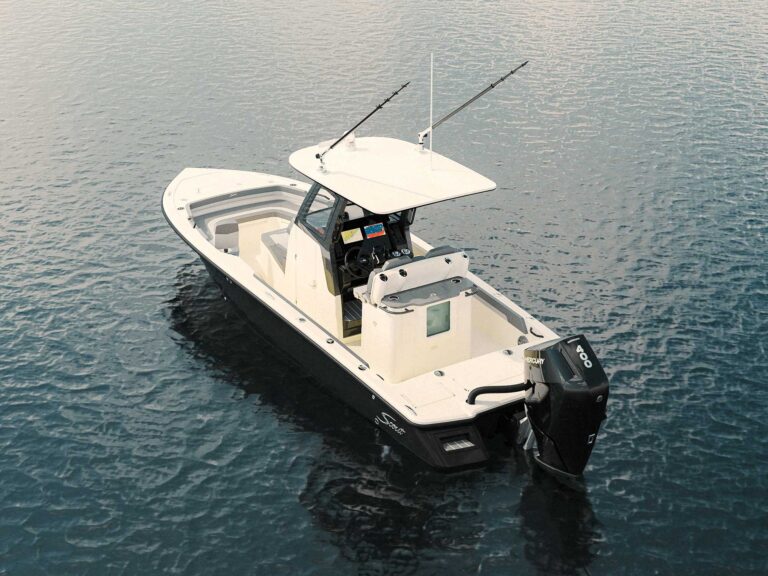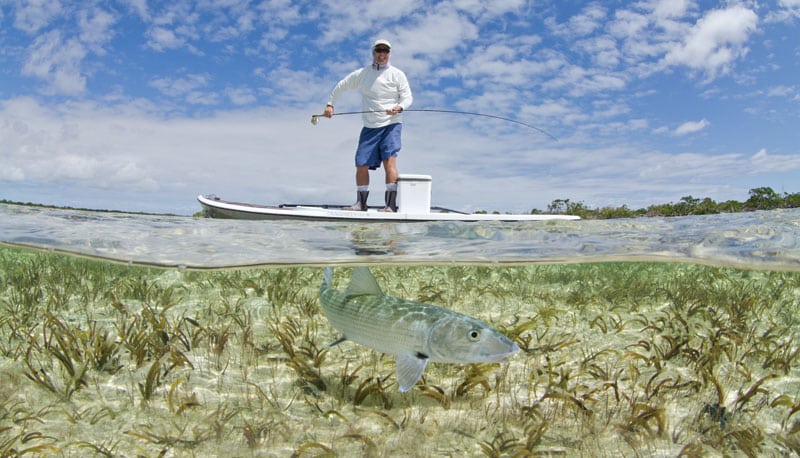
By nature, fly-fishermen crave exploration and discovery. Some anglers prefer to pole small skiffs along the shallows, and others enjoy strapping on wading boots to creep along hard-bottom flats. Kayaks and canoes afford a peaceful yet mobile pursuit. Creative land-based anglers even manage to find new water, often by putting themselves in precarious positions or compromising situations. No matter what discovery-seeking method you choose, you’ll find a unique perspective of the saltwater world.
In all the years I’ve spent fly-fishing, I thought I had experienced them all. I was proven wrong when I walked on the water of South Caicos, in the Turks and Caicos Islands.
The very instant I set foot on a stand-up paddle board about a year ago, my brain threw any fitness benefits of this relatively new sport out the window. Instead of paddling around and enjoying my maiden voyage, I thought about how deadly this surfboard-like watercraft could be on the flats.
Not long after this revelation, I was in contact with longtime Fly Fishing in Salt Waters contributor Mark B. Hatter about fishing the no-motor zone of Florida’s Indian River Lagoon. I told him that in lieu of a canoe or a kayak, I’d be toting a stand-up paddle board for this outing.
Hatter is an excellent angler and knows this area very well, but I was confident that with a paddle board under my feet, I’d be doing most of the catching this time. I wish I could say that I put Hatter to shame, but my day was a complete failure. To make a long story short, within five minutes of being on the flat, I saw a fish and somehow managed not to spook it. When I bent down to grab my rod, I lost my balance and fell into the cold water. That was at about 6:30 a.m. and was par for the course the rest of the day. While Hatter was busy casting to, hooking, catching and releasing fish after fish, I was busy thinking of more ways to swear at a paddle board.
When we returned to land, I made a solemn vow never to fish from one again. After such a hellish day, I was convinced that catching a fish on fly from a paddle board was a novelty and nothing more.
A Second Chance
Being a man of my word, I stayed true to my promise — for a while, that is. A few days after what I considered one of the most embarrassing fishing outings of my life, I received a phone call from Hatter. When I answered, I could detect a suspicious smirk on his face just by the tone of his voice. Hatter was quite aware of my feelings about fishing from a paddle board, but he asked anyway. “So I just received an e-mail from Bibo Jayne in South Caicos. He said he’s got a few paddle boards on the island and that he’s getting pretty dialed in. I’ve already convinced Charlie Madden to come along — why don’t you join us and give it another try? I really think this could be good.” Hatter continued to put the squeeze on me, and because I have rubber-arm syndrome when it comes to islands and bonefishing, it didn’t take him long at all to convince me.
After arriving in Providenciales, Turks and Caicos, we made our way to the dock to jump aboard a water taxi to South Caicos. It was loaded down with everything from spare car tires to giant boxes of potato chips. Yes, we were among the locals.
Finally, we met Bibo Jayne of Beyond the Blue charters. As we settled in, I bombarded him with questions and explained my first and only experience fly-fishing from a paddle board. I was excited but remained skeptical. Jayne took myself, Hatter and Madden around to the back of the condo where we’d be staying to give us a rundown of how we would be fishing the next few days. Since opening his business in 1999, Jayne has become known for using an airboat to take his clients to the flats. This transport affords access to areas unreachable by any other type of craft, which gives his guests miles and miles of flats all to themselves.
As we rounded the corner, there was the airboat — loaded down with four paddle boards. Upon closer inspection, Hatter, Madden and I could see that Jayne had indeed done his homework. The boards had a unique shape — one that looked much more like the bow of a skiff than a paddle board. It looked as though hull slap actually might not be an issue. On the top of the board, I noticed a layer of SeaDek, which would keep things nice and quiet. Jayne then showed us the bottoms of the boards. Instead of the big fin that I remembered dragging bottom, Jayne had fabricated a long fin (roughly 3 feet) that ran lengthwise on the bottom of the board and hung down only about 2 inches. These aspects alone began to raise my expectations and confidence, though I still thought catching bonefish this way was going to be a just-to-say-I-did-it type of thing. Next, Jayne explained anchoring the boards, which measure 13 feet 6 inches in length. For the anchor system, Jayne ran a cord that’s approximately 20 feet long through the hull. On each end of this cord, he attached a 3-pound pyramid-shaped weight. This allows you to have a bow and a stern anchor to keep the craft in place while you cast to fish.
After going through the modifications, Jayne told us the typical scenario, which was actually quite simple. Strip out the fly line onto a homemade neoprene stripping matt, and set down the rod in front of your feet. Use a custom paddle like a push pole and move the board along just as you would a skiff. When you see a fish, pop the anchor cord from the clips, quietly set the paddle on top of the board, pick up the rod and make a presentation. After Jayne’s verbal demo, I was beginning to see the light.
Into the Creeks
As we made the run to the creeks the following morning, I couldn’t see anything but blue skies colliding with miles and miles of wide-open, crystal-clear flats. This scene, matched with the manner in which we were traveling, made it feel as though we were on another planet, gliding along in some
kind of spacecraft, spooking bonefish and barracuda all the way.
Jayne brought the airboat to a halt, and we tossed the anchor to unload the boards. We were all champing at the bit to begin our search for bones, and only seconds after Madden’s and Hatter’s boards slapped the surface, the two were off. “Good luck, guys! Keep your radios on, and if you get turned around, look for the push pole!” hollered Jayne. Being the considerate angler that I am, I stayed behind with our host to help unload the remaining two boards and stick a 20-foot flag in the mud to indicate the location of the airboat. Hatter and Madden were still in earshot, and I could hear the faint sound of screaming drags. I looked up to see that both of them had hooked up literally within five minutes of ever having set foot on a paddle board. This double hookup got my blood pumping, and with that, Jayne and I went our separate ways for the day.
Self-Guided
Most of us can appreciate a guided trip. However, there is something to be said about being all alone, poling where you want to pole and casting when you want to cast, without an added voice behind you. This really captures the essence of fly-fishing. Leaving on the board gave me a sense of freedom. I remember having this feeling as a kid when I would tell my mom that I’d be home by dinnertime and then take off on my bicycle for the whole day to do one thing — explore. In the creek system of South Caicos, anglers can’t help but explore. Jayne explained that many of the creeks we would be on had never been fished. It was amazing. One would open up to another and then another, and so on. The best part of this was that bonefish were everywhere — and they were eager to eat.
In a matter of minutes, I had a newfound love of paddle-board fishing and realized that, when done correctly, it’s not a novelty at all — instead, it is a highly effective method of stalking fish. I have always enjoyed wading, but being that low to the water often presents problems with visibility. These boards allow you to essentially wade on top of the water. My first cast confirmed all of this. I was poling a narrow cut in the mangroves and caught a glimpse of sunlight reflecting off the tail of a good-size bonefish. It was out of casting range, but I was able to slowly sneak closer and closer. I figured that when I set the paddle down to drop the anchor, the fish would spook. But it didn’t. It continued to feed. When I dropped the anchor, I heard nothing, and once again, the fish proceeded to bury its nose in the mud. As soon as I was upright, with the rod in my hand, I knew it was game over for this fish. I made the long cast, and the Gotcha landed a couple of feet from the fish’s nose. As soon as the bone noticed my fly, its fins became erect, and it rushed the fly and ate immediately.
When we all reconvened at the airboat, we simultaneously relayed how many fish we saw, how many ate, how we lost a big one in the bush, etc. It was a complete mush of fish stories — we sounded like a bunch of girls talking about the royal wedding. Jayne sat back and smiled at our childlike giddiness.
Getting the Hang of Things
Over the next couple of days, the four of us continued to fish, sometimes solo, sometimes in pairs and sometimes all together, spread out across gigantic white-sand flats. In the same way that proficient fly-anglers don’t have to think about casting mechanics, the more we fished from paddle boards, the more involuntary the operations became. We were all getting sharp. At the end of the second day, Madden said it best: “I can’t even count how many fish Mark and I landed today — simply unbelievable.” I don’t have any problem stating that Madden, Hatter and Jayne are excellent fly-anglers. However, I honestly have to give some credit to the method in which we fished. First, the boards allowed us to be extremely stealthy. Second, they made it possible for us to get into areas that have never been fished before. Third, and maybe even more importantly, they gave us the ability to fish in spots that were unwadable due to mud bottoms. And fourth, the biggest advantage — they offered incredible coverage. Until recently, Beyond the Blue was a wading operation. I spent three days on a paddle board and compared the amount of water we covered to how much we would have if we’d been wading — to say the difference was night and day would be an understatement. For example, one afternoon I tagged along with Jayne and fished an entire loop of flats and creeks and caught fish the entire time. Google Earth showed that we fished about five linear miles in about a half-day. You can’t wade this loop due to the mud bottom, but even if you could, you’d be lucky to cover that amount of water on foot in a full day.
What I thought was going to be nothing more than yet another way to catch fish turned out to be something completely different. I figured, yeah, sure, maybe we’ll catch some fish, but we’ll be lucky to catch a few each day. This impression was completely wrong. I came to realize that fly-fishermen haven’t even scraped the surface of how to go about catching fish. But best of all, I enjoyed the sense of exploration and discovery that I so desperately crave.
Board 101
When selecting a stand-up paddle board, be careful. Those designed to ride waves and casually cruise don’t offer many advantages to fly-fishermen. A paddle board may look like a relatively simple object, but take my word for it, the details make all the difference. Luckily, many designers have been creating boards that cater to the needs of anglers. The list below should help in your search for the perfect platform.
Aguera Design
808-283-9110
Board Fisher
760-331-7036
Bote
850-424-5010
Diablo Paddlesports
512-282-2628
Dragonfly Boatworks LLC
772-567-8835
Three Brothers Boards
386-310-4927

